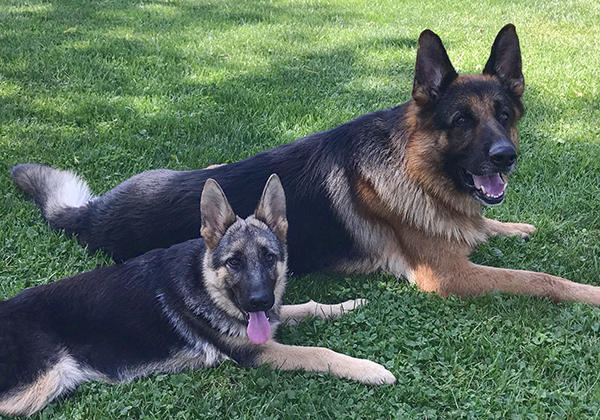Looking for a German Shepherd breeder in Florida? You're in luck! We have compiled a list of the 10 best breeders in the state. Whether you are looking for a show dog, a working dog, or just a family pet, we have the perfect breeder for you. Keep reading to learn more about these top-rated breeders and what they have to offer.
1. Southernwind Kennels German Shepherd breeder in Florida.
Location: Brooksville, Florida
Website:southernwindk9.com
Address:19115 Phillips Road,Brooksville Fl 34604,M Cecilia Martinez
Phone:787-509-8857/ 352-942-9427
Southernwind Kennels, located in Brooksville, Florida, is a German Shepherd breeder that specializes in producing world-class puppies. Because they were bred with performance in mind, many of their GSDs go on to be excellent K9s and service dogs.
Initially, this kennel began as a training facility for mounted police horses. As a result, it has a distinct background in tactical-specific sensory procedures, allowing it to produce the best possible breeding results.

Puppies of German shepherds are available all year.
They provide the following guarantees:
- Healthy (DM clearances)
- FCI/SV Hips and Elbows Certificated
- Working Certification (Conformation FCI titles)
- High-level performance abilities
Even if you're just looking for a family pet, this kennel is worth a look because their dogs make exceptional companions for everyone.
2. South Florida German Shepherds.
Location: Hollywood, Florida.
Website:southfloridashepherds.com
Email: info@southfloridashepherds.com
Phone:(305) 904-9796
South Florida Breeders is a family-owned company that has been producing world-class German Shepherd puppies since 1996 in the United States and 1980 in Germany. They are dedicated to providing high-quality dogs and puppies.
All of their German shepherds are EU imports from the world's most famous bloodlines, including Remo Vom Fichtenschlag, Yasko Vom Funkenspiel, and Vegas Du Haut Mansard, to name a few.
Show line German Shepherds are imported from West Germany while the Working and Service line German Shepherds are imported from the Czech Republic.
They only breed German shepherd puppies for home companions or for IPO, Home Protection, Personal Protection, or K-9 Units.
During the breeding program, all of their German Shepherds are carefully selected, and they guarantee a genetic health guarantee-free of all genetic health conditions, such as dysplasia.
The puppies have passed the AKC's stringent testing requirements. Their German Shepherds are registered with SV, USCA, FCI, KKS, and MET in addition to the American Kennel Club.
Their dogs' coats come in a variety of colors, including sable, black/tan, and black/red. They also have beautiful black German Shepherd puppies for sale. Their coats have either short or long hair.
They aim to improve the dogs' conformation, socialization skills, and temperament.
When the puppies arrive, they will have been dewormed and microchipped. You will also receive lifetime breeder support, AKC registration papers, and a German Shepherd puppy starter package.
3. Florida German Shepherd Puppies.
Location: Orlando, Florida
Website:germanshepherdspuppy.com
Address:3045 Griffin View Dr Lady Lake, FL 32159(By Appointment Only)
Phone:(407) 489-5877
Florida German Shepherd Puppies is a hobby breeder run by a family. Started in 2001 when a German Shepherd puppy brought joy to their son during his cancer treatment.
They claim to have extremely strong German Shepherd breeds with a lineage dating back to the 1900s. Some breeds are:
- West German Show Lines and Saddlebacks
- Czech German Shepherds
- DDR German Shepherds
- The European German Shepherd
American German Shepherd
Their German Shepherds are bred and trained for protection, companionship, and friendship. Their dogs often go to police officers and their families, and many of them are used as cadaver search dogs or to assist those with disabilities.
4. Ruskin House of Shepherds.
Location: Tampa, Florida
Website:ruskinhouseofshepherds.com
Address:
Email:ruskinshepherds@gmail.com
Phone:941-321-2305
Ruskin House of Shepherds is one of the best German Shepherd breeders in the US. They breed well-balanced German Shepherd puppies, known for their striking looks and affectionate temperaments.
Ruskin House of Shepherds is one of the few breeders on our list that produces and sells dogs in a wide range of coat colors, standard and rare colors; black and red, black and tan, sable, solid black, solid white, silver, silver sable, black sable, liver, panda, and blue German Shepherds with standard, plush, and long coats.
Apart from doing their own breeding, Ruskin House of Shepherds also imports European German Shepherds.
They are open to shipping the puppies as long as you meet the criteria.
This breeder promises to give each of its customers a healthy, playful, and athletic puppy with a distinct personality.
5. Be Bright German Shepherds—German Shepherd Puppies For Sale In Central Florida.
Location: Eustis, Central Florida.
Website: bebrightgermanshepherds.com
Address:36045 Fentress Ln Eustis, FL 32736 (By Appointment Only)
Email: info@southfloridashepherds.com
Phone:(352) 978-9392
Be Bright German Shepherd Breeders has been breeding top-quality German Shepherds for over ten years.
All of these puppies are AKC-registered, and you will receive your puppy's registration paperwork when you pick up your new family member.
The puppies will also have received their first shots, been dewormed, will have a health certificate, and will be guaranteed to be healthy.
They have a 23-acre farm where their dogs can run around and play. They also have a kennel where the dogs can spend time indoors with air conditioning to keep them cool in hot weather.
Furthermore, they do not ship puppies, but they can meet you halfway within a reasonable driving distance or arrange alternative options if necessary.
Their website is being constantly updated with the most recent German shepherd puppies for sale.
6. Florida German Shepherd puppies Dog Breeder.
Location: Fort White, Florida.
Website: shepherds-for-sale.com
Address:36045 Fentress Ln Eustis, FL 32736 (By Appointment Only)
Email: paintedstarstables@yahoo.com
Phone:727-743-4089
Located in Florida, the Florida German Shepherd puppies breeder is a family-owned and operated business that maintains a breeding program for both imported and American-bred German shepherds.
They fed their dogs a raw food diet that was specifically designed for their breed. This company's website, star-canine.com, also sells German shepherd supplements and other supplies, as well as other dog food and supplies.
Working with a Florida German Shepherd pups breeder is a terrific option if you are seeking a great German Shepherd puppy or adult dog for work, protection, showing, or as a family pet.
They have been breeding top-quality German shepherd dogs for a while now, and they are considered to be one of the most reputable breeders in the region.
The German Shepherd puppy breeder in Florida claims to put your satisfaction above anything else in the breeding process. In collaboration with you, they will identify and select the most suitable German shepherd for your needs and preferences.
If you are looking for a reputable and reliable breeder of German Shepherds in Florida, then these 11 breeders should be at the top of your list. Each of them has a long history of breeding healthy, happy, and beautiful puppies that make excellent family pets or working dogs.
7. Von Calvo German Shepherds.
Location: Fort White, Florida.
Website: voncalvo.com
Email:voncalvo@aol.com
Address:Von Calvo German Shepherds Inc. 1811 SW 92 PLACE, Miami, FL 3316V
Phone:(786) 271-0118
Von Calvo is a one of the best German Shepherd breeder that is family-owned and AKC-registered.
They have a successful selective breeding program in which they only use the best German Shepherd bloodlines imported from Germany and elsewhere.
Von Calvo has received numerous awards, including the VA1 (Excellent Select Champion) title in both the male and female adult categories the same year. They were named the best German shepherd producer in 2019.
All of their German shepherd puppies and adult dogs for sale have been temperament, character, and confirmation tested.
8. The Lord's Shepherd
Location: Clermont, Florida.
Website: thelordsshepherds.com
Email: thelordsshepherdsk9@gmail.com
Phone:352-2235145
The Lord's Shepherd Kennel is a 5-star kennel that has been in business since 2000.
They breed quality straight-backed German Shepherds from champion imported DDR Working Lines (East German Lines) and Czech lines mixed with quality Show lines to even out the backline and balance the drive/energy.
The puppies are backed by a two-year guarantee, allowing you to be assured in the health of your new companion.
These dogs are incredibly intelligent and easy to train, which makes them excellent for households with children. If you so desire, they can also be trained to serve as guard/protection dogs if you so desire!
9. Appleridge German Shepherds
Location: Ocala, Florida.
Website:appleridgegsd.com
Phone: (423)457-3808
Appleridge German Shepherds is one of Florida's top German Shepherd breeders. They have been deeply committed to the breed for over a couple of years, and they are one of the only breeders in the state to have both AKC and SV (German Shepherd Dog Club of America) breeding permits.
They are a small, family-run kennel that breeds German Shepherds for companionship or working purposes. Most of their dogs have multiple titles, such as Obedience, Trick Dog, Rally, Assistant Dogs and Agility +++.
They breed German Shepherd dogs that are versatile, stable, loving, loyal, extremely smart, and trainable from the best West German lines in the world.
Their breeding stock is all OFA certified for hips, elbows, heart, and diabetes. Their breeding stock is also VWD-free, so their puppies will not contract the disease.
They strive to breed German Shepherds that are healthy, happy and have good temperaments. They also have a small number of retired adults who are looking for loving homes! Please contact them if you are interested in adopting one of these pets.
10. Redland Vom Schaferhunde - Redland German Shepherds
Location: Miami, Florida.
Website:redlandvomschaferhunde.com
Emial: mechezarreta221@yahoo.com
Phone: 786-280-1251
For more than three decades, Redland has been a leading German Shepherd breeder in Florida, and it is widely considered to be one of the best.
They breed German Shepherds and provide a stud service, drawing on the best genetics acquired from Germany to achieve their success. Their puppies come with a health guarantee, which makes them one of the few breeders who do so.
If you decide to purchase a German Shepherd puppy from them, they can assist you with the full process of bringing your new pet into the country in order to make it as seamless as possible for you and your loved ones.
A hereditary hip and elbow guarantee, current vaccinations and deworming, a microchip, and AKC registration papers are all included with every puppy purchased from Puppy Heaven.
Puppy colors include dark black & red with superb conformation and disposition. The puppies are available in two sizes: small and medium.
What Are Your Thoughts On The Best German Shepherd Breeders In Florida?
If you are looking for a reputable and reliable breeder of German Shepherds in Florida, then these 11 breeders should be at the top of your list. Each of them has a long history of breeding healthy, happy, and beautiful puppies that make excellent family pets or working dogs.
We hope this list will help you decide which of these kennels are best for your family and pets. Do any of them sound like a good fit? What other factors do you think should be considered before making this decision?
Remember, this is one of the most important decisions that you will make in your life, so take some time to research these breeders before contacting them.
The German Shepherd makes a wonderful companion dog, as well as a guard dog if trained properly. The breed has been used in many roles throughout history, including therapy and search-and-rescue.
If you have any questions about the breed or their temperament then feel free to contact your local German Shepherd rescue for more information on how this amazing dog can enrich your life.
Are there any other Florida German shepherd breeders that should be on this list?
Please let us know by leaving a comment below.
